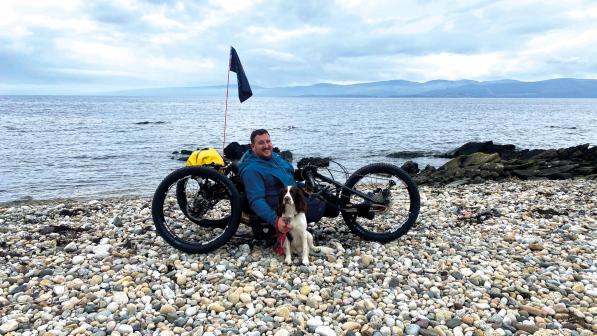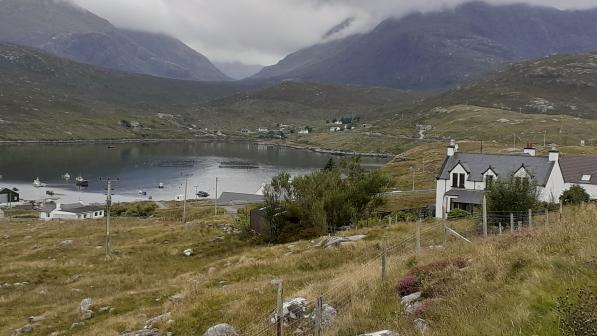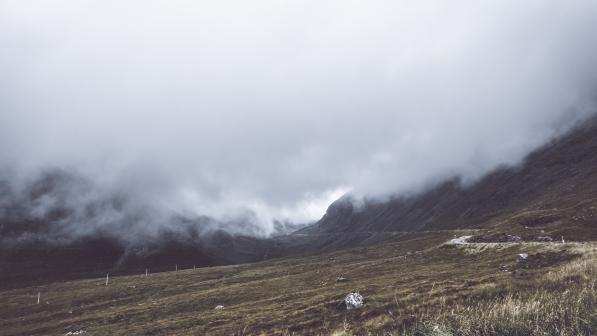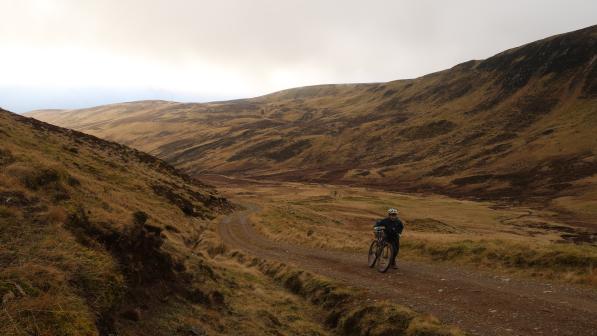Great rides: Hebrides by hand

"Those 30mph winds last night were pretty impressive!” I said to the campsite owner on the Isle of Coll as we packed up our tent. There had been little shelter from the gusts: the island’s landscape is beautiful and rugged but wide open.
but wide open. “Well, the forecast is for 50mph winds on Tiree for the next couple of days,” he replied, with a look of concern. Tiree was the next island on our trip, and the one we were getting the ferry to in the next hour.
The islands off the west coast of Scotland are renowned for their azure waters, brilliant white sands, and communities of warm and welcoming people. When the weather is equally hospitable, there are spectacular views from quiet roads and endless opportunities for adventure. It’s no wonder that so many cyclists visit.

Unfortunately the weather wasn’t particularly warm or welcoming for my own handcycling tour. That wind! Nonetheless, as a wheelchair user and adaptive rider who continues to explore the opportunities and freedom that handcycling returns to me, it promised to be the trip of a lifetime. I’d be exploring from Arran up to the Isle of Lewis, and seeing my homeland in a way that few adaptive riders have done before.
Unsupported long-distance bikepacking is a logistical challenge I’ve yet to master, as it requires the transportation of a wheelchair as well as a whole host of other additional gear. So I was lucky to rope in two family members to drive a support vehicle.

My partner, Jess, joined me for the first leg of the trip. After driving up from our home in North Wales, she accompanied me across Arran, Gigha, Islay, Jura, and Mull. My dad, Ken, took over the baton as driver for the second part of the trip through Coll, Tiree, Barra and Vatersay, and all the way up the Hebridean Way before our return to the mainland at Ullapool.
Despite their support, it was a little daunting to tackle an adventure of this length. “However things pan out,” I told myself, “it’ll all be fine.”
Chiming with the Arran Belles
We couldn’t have asked for a more welcoming start to the trip than meeting with Janice and Murray on arrival to Arran. Janice had kindly offered to meet with us and give us a place to unload and put together my handcycle before starting the journey.
After a good chat about our shared love of cycling and all it offers over a glass of Scottish blend, we set off to meet up with more members of the Isle of Arran Belles. This all-ladies cycling group not only guided me around the south of Arran from Brodick but also provided us with the loveliest lunch and conversation. They set the bar very high on day one.
I always like to talk with other cyclists, often informing them about adaptive riding. So it was great being able to talk to the ladies about the beauty of Scotland and the freedom that cycling, in all its forms, offers people. The weather that day was perfect for cycling: warm and dry enough to not have to worry about waterproofs yet sufficiently windy and early enough in the season to not have to face the swarms of midgies that Scotland is famous for.

Jess and I camped at Lochranza that first night, in a bigger tent than the backpacking model we had originally planned to use. This one had a porch suitable for my wheelchair. It was the right decision, due to the comfort it gave me as an adaptive rider on an extended camping adventure.
We then headed back to the mainland briefly, where I cycled from one ferry port to another so we could take a ship to one of Scotland’s more remote islands, Gigha. Here, Jess struck gold by discovering a remote wild camping spot on the northernmost point of the island. It offered exactly the sort of peaceful seclusion we had hoped to encounter on the trip. As we settled in for the evening, sitting around a campfire and looking out over the bay, it was hard to know who was more content, us or our springer spaniel, Buster.
Recharging my batteries
By the time we were crossing Islay and Jura, I’d started to realise how different cycling is on this scale – riding for many days, back-to-back – compared to the cycling I’d done previously. Despite a background in outdoor education and an awareness of sport and nutrition, it surprised me how far off the mark and unprepared I was when it came to fuelling my journey.
I’d also underestimated the impact that poor sleep would have on me and my ability to put in the miles each day. We had to make a lot of on-the-spot adaptations, sometimes changed our plans, and I had to start consuming more calories.
My problem-solving skills were tested when finding and booking campsites with an electric hook-up and accessible facilities
Hand cyclist and disability access consultant, Neil Russell
My problem-solving skills were tested when finding and booking campsites with an electric hook-up and accessible facilities. The electric-assist handcycle I was riding required its batteries charging more often than I thought it would. The Lasher ATH-FS (full suspension) trike with e-assist and gravel tyres was nevertheless a great choice, taking mixed surfaces in its stride. The suspension meant a much smoother ride: a trike encounters more bumps than a two-wheeler and all of them would otherwise come through to me. Large volume gravel tyres set up tubeless were also ideal. I had no issues with punctures or loss of traction on hills.
An adventure assessed
With the benefit of hindsight, I was naive when I went into this trip. Yet without such naivety I may never have begun it. I had the time and I wanted to challenge and push myself to see what I could do. Away from home, remote, yet still close enough to bail out if everything went wrong, the islands off the west coast of Scotland were exactly the right location for such a trip. It was environment that allowed me – a relative newcomer to the freedom provided by handcycle touring – to discover what kind of rider I am… and am not!
I had expected the blue water, green rolling hills, and white sands that tourism adverts and social media show us. Instead, I had about a day and a half total of blue skies and sunshine over the whole three-week trip. Consequently, we often camped in muddy ‘campsites’, using facilities that were challenging to say the least. We had to put up and down a tent nearly every day in wild winds. I had to accept that this was the adventure I’d planned, and just keep cycling.

I lived in Scotland for 35 years so shouldn’t have expected perfect weather. Yet I did. It was overly optimistic. The trip became a whole different kind of challenge, more about endurance than enjoyment at times. It taught me the hard way what kind of rider I am.
Writing this a few weeks after the trip has given me a clearer perspective about myself, what I enjoy, what I find manageable as an adaptive rider, how the type of riding I do fits within a mainstream cycling world, and what types of cycling adventures I’ll embark on going forwards. Though perhaps not all that I had hoped it would be, my adventure across the islands of Scotland was an opportunity not afforded to all, and it’s one that will forever influence my riding in the future.
Do it yourself: Adaptive bike touring
- Choose comfortable accommodation. Camping feels more of an adventure but after a long day handcycling, a hot shower and bed help to recharge your own batteries.
- Give yourself time to explore. Racing from A to B to get to a ferry is not the same as immersing yourself in the environment.
- Be realistic about the weather you are likely to encounter. And be prepared for it to be even worse than you can imagine...
- Don’t be put off by access issues. Given some research and time spent e-mailing and phoning, you may be surprised how accommodating and accessible most places can be.
- Be safe. The backup of other riders or a support vehicle helps stop minor mechanicals turning into full-scale evacuation situations.




